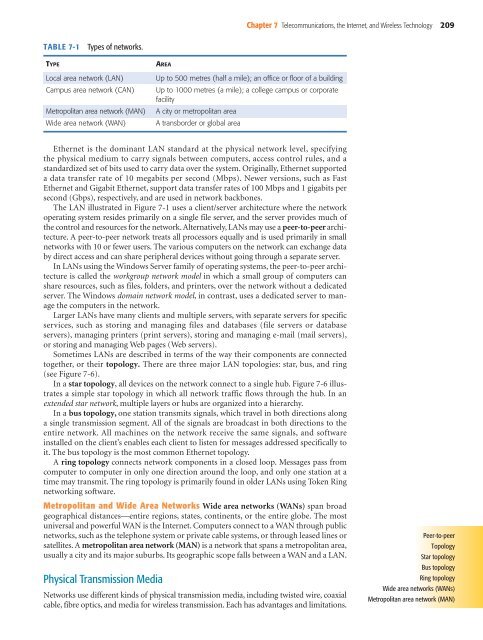Telecommunications, the Internet, and Wireless ... - Pearson Canada
Telecommunications, the Internet, and Wireless ... - Pearson Canada
Telecommunications, the Internet, and Wireless ... - Pearson Canada
You also want an ePaper? Increase the reach of your titles
YUMPU automatically turns print PDFs into web optimized ePapers that Google loves.
Chapter 7 <strong>Telecommunications</strong>, <strong>the</strong> <strong>Internet</strong>, <strong>and</strong> <strong>Wireless</strong> Technology 209<br />
TABLE 7-1<br />
Types of networks.<br />
TYPE<br />
Local area network (LAN)<br />
Campus area network (CAN)<br />
Metropolitan area network (MAN)<br />
Wide area network (WAN)<br />
AREA<br />
Up to 500 metres (half a mile); an office or floor of a building<br />
Up to 1000 metres (a mile); a college campus or corporate<br />
facility<br />
A city or metropolitan area<br />
A transborder or global area<br />
E<strong>the</strong>rnet is <strong>the</strong> dominant LAN st<strong>and</strong>ard at <strong>the</strong> physical network level, specifying<br />
<strong>the</strong> physical medium to carry signals between computers, access control rules, <strong>and</strong> a<br />
st<strong>and</strong>ardized set of bits used to carry data over <strong>the</strong> system. Originally, E<strong>the</strong>rnet supported<br />
a data transfer rate of 10 megabits per second (Mbps). Newer versions, such as Fast<br />
E<strong>the</strong>rnet <strong>and</strong> Gigabit E<strong>the</strong>rnet, support data transfer rates of 100 Mbps <strong>and</strong> 1 gigabits per<br />
second (Gbps), respectively, <strong>and</strong> are used in network backbones.<br />
The LAN illustrated in Figure 7-1 uses a client/ server architecture where <strong>the</strong> network<br />
operating system resides primarily on a single file server, <strong>and</strong> <strong>the</strong> server provides much of<br />
<strong>the</strong> control <strong>and</strong> resources for <strong>the</strong> network. Alternatively, LANs may use a peer-to-peer architecture.<br />
A peer-to-peer network treats all processors equally <strong>and</strong> is used primarily in small<br />
networks with 10 or fewer users. The various computers on <strong>the</strong> network can exchange data<br />
by direct access <strong>and</strong> can share peripheral devices without going through a separate server.<br />
In LANs using <strong>the</strong> Windows Server family of operating systems, <strong>the</strong> peer-to-peer architecture<br />
is called <strong>the</strong> workgroup network model in which a small group of computers can<br />
share resources, such as files, folders, <strong>and</strong> printers, over <strong>the</strong> network without a dedicated<br />
server. The Windows domain network model, in contrast, uses a dedicated server to manage<br />
<strong>the</strong> computers in <strong>the</strong> network.<br />
Larger LANs have many clients <strong>and</strong> multiple servers, with separate servers for specific<br />
services, such as storing <strong>and</strong> managing files <strong>and</strong> databases (file servers or database<br />
servers), managing printers (print servers), storing <strong>and</strong> managing e-mail (mail servers),<br />
or storing <strong>and</strong> managing Web pages (Web servers).<br />
Sometimes LANs are described in terms of <strong>the</strong> way <strong>the</strong>ir components are connected<br />
toge<strong>the</strong>r, or <strong>the</strong>ir topology. There are three major LAN topologies: star, bus, <strong>and</strong> ring<br />
(see Figure 7-6).<br />
In a star topology, all devices on <strong>the</strong> network connect to a single hub. Figure 7-6 illustrates<br />
a simple star topology in which all network traffic flows through <strong>the</strong> hub. In an<br />
extended star network, multiple layers or hubs are organized into a hierarchy.<br />
In a bus topology, one station transmits signals, which travel in both directions along<br />
a single transmission segment. All of <strong>the</strong> signals are broadcast in both directions to <strong>the</strong><br />
entire network. All machines on <strong>the</strong> network receive <strong>the</strong> same signals, <strong>and</strong> software<br />
installed on <strong>the</strong> client’s enables each client to listen for messages addressed specifically to<br />
it. The bus topology is <strong>the</strong> most common E<strong>the</strong>rnet topology.<br />
A ring topology connects network components in a closed loop. Messages pass from<br />
computer to computer in only one direction around <strong>the</strong> loop, <strong>and</strong> only one station at a<br />
time may transmit. The ring topology is primarily found in older LANs using Token Ring<br />
networking software.<br />
Metropolitan <strong>and</strong> Wide Area Networks Wide area networks (WANs) span broad<br />
geographical distances—entire regions, states, continents, or <strong>the</strong> entire globe. The most<br />
universal <strong>and</strong> powerful WAN is <strong>the</strong> <strong>Internet</strong>. Computers connect to a WAN through public<br />
networks, such as <strong>the</strong> telephone system or private cable systems, or through leased lines or<br />
satellites. A metropolitan area network (MAN) is a network that spans a metropolitan area,<br />
usually a city <strong>and</strong> its major suburbs. Its geographic scope falls between a WAN <strong>and</strong> a LAN.<br />
Physical Transmission Media<br />
Networks use different kinds of physical transmission media, including twisted wire, coaxial<br />
cable, fibre optics, <strong>and</strong> media for wireless transmission. Each has advantages <strong>and</strong> limitations.<br />
Peer-to-peer<br />
Topology<br />
Star topology<br />
Bus topology<br />
Ring topology<br />
Wide area networks (WANs)<br />
Metropolitan area network (MAN)
















